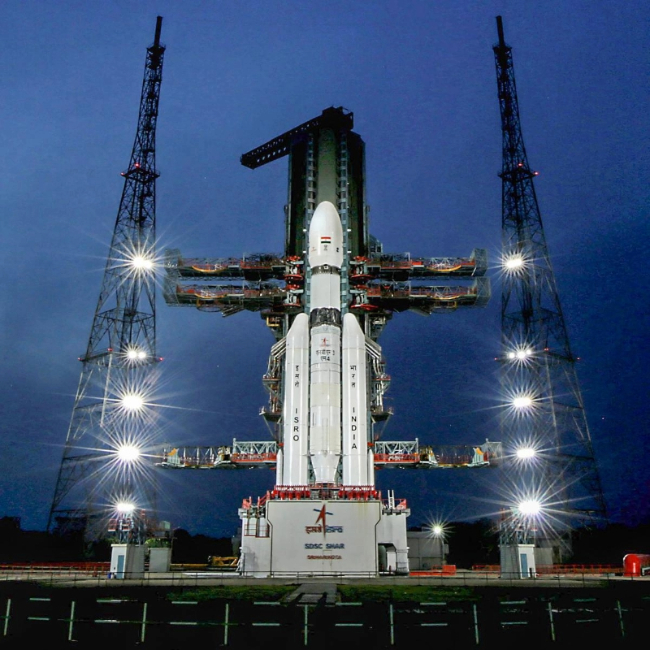Chandrayaan-3
India is racing to the moon, this expedition is for lunar water resources, and also a competition with other international agencies such as NASA. All international agencies for space research aim to understand our heavenly neighbour better, undo its secrets, and utilize its potential for the future of humankind. Chandrayaan-3 and NASA’s Artemis program — are the vehicles for this exploration. These two different programs have different approaches and employ unique technology and mathematical principles. In this article, we investigate the technical details and mathematical mechanisms handled by the agencies for ambitious endeavours, and sketch comparisons to lighten how each navigates the challenges of lunar exploration. https://www.isro.gov.in/Chandrayaan3.html
Chandrayaan-3’s Distinctive Features
Lander is a primary distinctive feature of Chandrayaan-3 as it’s unique. It is designed for landing in the south pole region of the moon. This region is not like the equatorial regions where NASA’s Apollo missions landed. This south pole region has rocky, cratered terrain and temperatures are extremely low. So, the lander has been designed to handle these harsh conditions and carry out its mission objectives successfully.
The lander’s design involves sophisticated sensor technology to guide the descent and landing process. To identify the landing site and for safe navigation, ISRO has used High-resolution cameras, Laser Altimeters, and Hazard Detection and Avoidance (HDA) systems. Also, ISRO has used innovative technology and design solutions for high-speed processing of sensor data, real-time decision-making, and precise control of thrusters.
Another important unique feature of this mission is that the rover Chandrayaan-3 is solar-powered and can communicate with the Earth directly. Its six-wheeled robotic vehicle uses solar energy for its functioning and can endure harsh lunar nights due to its thermal control system.
https://www.isro.gov.in/Chandrayaan3_Details.html
https://www.space.com/chandrayaan-3-moon-south-pole-why-nasa-wants-to-go-too
Mathematics: The Invisible Power Behind the Missions
The successful launch, navigation, and landing of any space mission are deeply rooted in mathematics. From the physics of rocket propulsion to the calculations of orbital mechanics, mathematics plays a pivotal role. Let us explore the mathematical concepts and their application in the background of the Chandrayaan-3 and NASA’s lunar missions.
Rocket Propulsion: Tsiolkovsky’s Rocket Equation
The fundamental principle of rocket propulsion can be captured by Tsiolkovsky’s rocket equation. This equation relates the velocity change of a rocket to its initial and final mass (including and excluding fuel, respectively), and the effective exhaust velocity of its propellant. It is defined as:
Change in velocity = effective exhaust velocity * ln(initial mass of rocket and propellant /final mass of rocket)
This equation dictates how much velocity change a rocket can achieve given its mass and the characteristics of its propellant, effectively governing the choice of rocket and propellant for a mission like Chandrayaan-3 or NASA’s lunar missions.
Orbital Mechanics: Hohmann Transfer and Translunar Injection
The trajectory from Earth to the moon, whether it’s the slower, more gradual trajectory followed by Chandrayaan-3 or the Direct Translunar Injection (TLI) used by NASA, is dictated by the principles of orbital mechanics.
For a Hohmann transfer, the spacecraft initially orbits the Earth, and then a precisely timed boost (the trans-lunar injection) sends it on a path to intersect the Moon’s orbit. The required Change in velocity for each maneuver is calculated by the Vis-viva equation. Vis-viva equation in celestial mechanics which relates the speed of an object in an elliptical orbit to its position and the mass of the body being orbited:
Square of velocity of the orbiting object = gravitational constant * mass of the central body (Earth for the initial orbit) * (2/ distance of the object from the central body — 1/ distance of the object from the central body)
NASA’s Direct Translunar Injection method involves a faster, more direct trajectory to the moon, again depending on precise calculations of Change in velocity at each stage of the journey.
Lunar Landing: Navigation and Hazard Avoidance
Mathematics concepts are used for navigation and hazard avoidance and this helps the final stages of a lunar mission, such as the descent and landing of a lunar rover. For instance, Chandrayaan-3 uses a combination of high-resolution cameras and laser altimeters to navigate to a safe landing site. The data from these sensors are processed in real-time, with algorithms identifying safe landing sites based on factors like slope, roughness, and lighting conditions. (Source: https://medium.com/predict/moon-race-chandrayaan-3-vs-nasas-tech-and-math-secrets-6a73662fff44)
https://www.jagranjosh.com/articles/chandrayaan-3-working-principles-1692784227-1
Conclusion
Chandrayan-3 is evident in how significant scientific goals are achieved with small and cost-effective vehicles. International space research agencies such as NASA, and ISRO are different in their methodologies, and unique contributions to lunar exploration and space research.
Featured Image Source: https://images.app.goo.gl/PJRdyowduMixSAmDA

